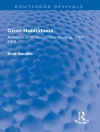Originating from discussions about the reasons for, and regional variations behind, the remarkable rise in cohabitation that started in the 1970s – a rise that continues to this day – this book explores the main stimuli behind cohabitation. The variation in levels of cohabitation cannot be explained solely by regional differences, religious affiliation, nationality, levels of education, or by the varying rate in which contraceptive measures spread across Europe. The book also focuses on the ways in which cohabitants are legitimized or rejected by certain communities. Did communities develop specific terms to define cohabitation and because of which underlying reasons were these different terms created? Illegitimacy is another phenomenon inseparably tied to cohabitation, based on the hypothesis that the understanding of marriage differs between societies and regions. In 1971, Shorter, Knodel and Van de Walle found that children born in rural Slavic communities in unlawful but stable, consensual unions were not recognised by civil law and the Church, and were registered as illegitimates, but in a cultural perspective were considered as legitimate. They also found more or less the same pattern in Scandinavian countries. This book explores the correlations that exist between illegitimacy and cohabitation across space and time in Europe? This book was originally published as a special issue of The History of the Family.
Jan Kok & Dalia Leinarte
Cohabitation in Europe [EPUB ebook]
A revenge of history?
Cohabitation in Europe [EPUB ebook]
A revenge of history?
¡Compre este libro electrónico y obtenga 1 más GRATIS!
Idioma Inglés ● Formato EPUB ● Páginas 156 ● ISBN 9781351741972 ● Editor Jan Kok & Dalia Leinarte ● Editorial Taylor and Francis ● Publicado 2018 ● Descargable 3 veces ● Divisa EUR ● ID 7215666 ● Protección de copia Adobe DRM
Requiere lector de ebook con capacidad DRM












